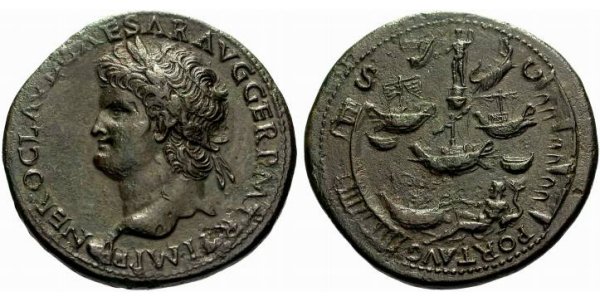
Numismatica Ars Classica NAC AG >Auction >Auction 27 (12.05.2004)
 |
| 写真提供: Numismatica Ars Classica NAC AG
|
 超拡大ボタン 超拡大ボタン |
| |
|
|
|
Numismatica Ars Classica NAC AG >Auction >Auction 27 (12.05.2004)
Lot :337
Price :19000 CHF (~14704 USD)
Description
The Roman Empire
Nero Augustus, 54-68
No.: 337
Estimate: CHF 18000
d=37 mm
Sestertius, Lugdunum circa 65, 23.26 g.
NERO CLAVD CAESAR AVG GER P M TR P IMP P P Laureate head l., with globe at point of neck. Rev. S - C Bird’s eye view of the harbour of Ostia. At the top faros surmounted statue of Neptune, holding sceptre; at bottom, reclining figure of Tiber l., holding rudder and dolphin; below, PORT AVG. To l. crescent shaped pier with portico. To r., crescent-shaped row of breakwaters. In the centre, eight ships. C 252. BMC 323 (this reverse die). CBN 75 var. RIC 441.
Very rare and a good specimen of this prestigious and desirable issue.
Struck on full flan and complete with a pleasant brown-green patina andgood very fine / about extremely fine
As an inland city of more than one million people during the reign of Nero, Rome relied heavily upon its Tyrrhenian Sea port at Ostia. Antioch, the great metropolis in Syria, was similarly positioned, as it was about the same distance (c. 15 miles) from its Mediterranean port at Seleucia. Though essential to major inland cities, ports and harbors were perhaps the most challenging of all engineering projects, and they were very costly to build and to maintain. It comes as no surprise that when great ports were completed, it was cause for celebration. To Romans, such occasions not only affirmed their international renown as engineers, but also represented a new opportunity to reap benefits in transportation, trade, grain supplies and military applications. The construction of a port at Ostia had been considered by both Julius Caesar and Augustus, but the projected expenses were so daunting that it was not until Claudius came to power that construction began; finally, it was finished during the reign of his adoptive son Nero. There are several variants of this famous reverse type, all of which show the harbor from a bird’s eye view, but which vary in the type and positioning of the vessels, which number from seven to twelve. Some fixed features are the breakwater and warehouses that form the perimeter, the Imperial statue at the top, the ocean-god Neptune holding a rudder and reclining on a dolphin at the bottom, and the inscription PORT AVG. As successful as the harbor proved to be, it was not infallible. Tacitus reports that in 62 a storm sank 200 vessels that were anchored within the harbor, and by the reign of Trajan the harbor had to be greatly expanded. The depiction on this particular coin shows eight vessels, ranging from large commercial ships to a small transport vessel.
show10goo 無断転用を禁止します。
| 
